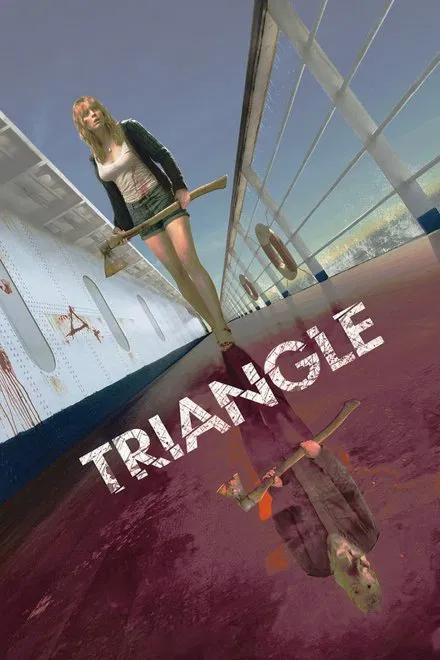
Directed by: Christopher Smith
Starring: Melissa George, Liam Hemsworth, Michael Dorman, Rachael Carpani
⛵ Introduction: A Voyage Into the Uncanny
Triangle (2009) is a psychological thriller that weaponizes the time loop trope, transforming a routine yachting trip into a nightmarish odyssey of guilt, denial, and infinite return. Christopher Smith crafts a Möbius strip narrative in which protagonist Jess (Melissa George) becomes both victim and perpetrator, trapped in an endlessly repeating cycle with no escape. The result is one of the most complex and disturbing timeline twists in modern cinema.
♾️ The Time Loop: Breaking Reality
The film’s plot begins simply enough: Jess, a single mother, joins friends for a sailing trip. A freak storm capsizes their boat, and the survivors board a seemingly abandoned ocean liner. Onboard, time and causality unravel. Jess encounters her own doppelgänger, and horrific events repeat with slight variations. The realization dawns: she is caught in a temporal loop, doomed to re-enact the same tragedy over and over.
Smith’s storytelling folds back on itself—scenes repeat from different angles, objects reappear with uncanny regularity, and Jess becomes both witness and architect of her own suffering. The effect is disorienting, relentless, and ultimately claustrophobic.
🪞 Guilt, Denial, and Self-Destruction
Beneath its sci-fi trappings, Triangle is a meditation on guilt and denial. Jess’s journey is revealed to be a purgatorial punishment for abuse and neglect of her son. The ship becomes a liminal space—a purgatory where Jess is forced to confront her actions without hope of absolution. Each failed attempt to change the outcome only deepens her torment, as the cycle restarts without mercy.
The twist, when it comes, is both horrifying and tragic: Jess’s efforts to “save” her friends and herself are revealed to be part of the mechanism that perpetuates the loop. Escape is impossible because Jess cannot forgive herself—her suffering is the price of denial.
🔄 Symbolism: The Myth of Sisyphus and Endless Return
Smith infuses the film with mythological resonance, drawing on the legend of Sisyphus—the man condemned to push a boulder up a hill for eternity. The ship’s endless corridors, looping staircases, and shattered mirrors reinforce the theme of repetition and self-confrontation. The film’s closing image—Jess staring at her own reflection, powerless to break the cycle—is a bleak but honest meditation on the human inability to escape the consequences of the past.
🎯 Final Thoughts: The Nightmare That Never Ends
Triangle is a masterclass in twisty, timeline-driven horror, using the logic of the loop to probe deep psychological wounds. Its power lies in its refusal to resolve the paradox, leaving viewers to grapple with the existential question at its heart: what if the only prison is the one we build for ourselves?